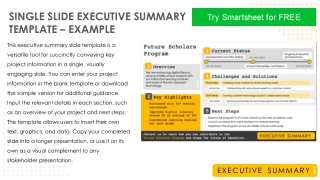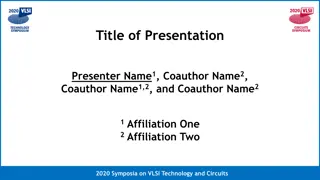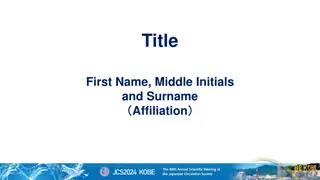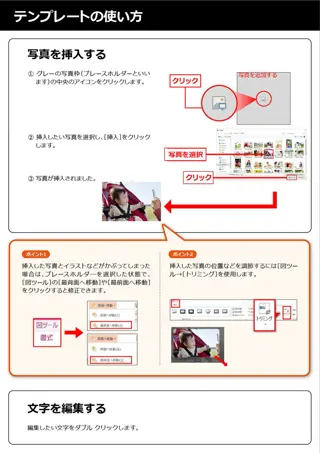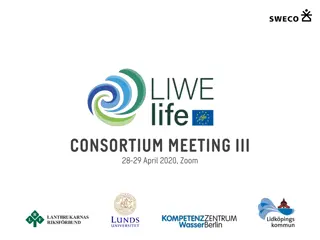
Evaluation of BEOL Design Rule Impacts Using Optimal ILP-based Router
Explore the evaluation of back-end-of-line (BEOL) design rule impacts using an optimal ILP-based detailed router through experimental results and conclusions. Learn how to choose patterning options and assess design rules independently of commercial EDA tools. Prior work in design rule evaluation and ILP-based routing solutions is discussed.
Download Presentation

Please find below an Image/Link to download the presentation.
The content on the website is provided AS IS for your information and personal use only. It may not be sold, licensed, or shared on other websites without obtaining consent from the author. If you encounter any issues during the download, it is possible that the publisher has removed the file from their server.
You are allowed to download the files provided on this website for personal or commercial use, subject to the condition that they are used lawfully. All files are the property of their respective owners.
The content on the website is provided AS IS for your information and personal use only. It may not be sold, licensed, or shared on other websites without obtaining consent from the author.
E N D
Presentation Transcript
Evaluation of BEOL Design Rule Impacts Using An Optimal ILP-based Detailed Router Kwangsoo Han , Andrew B. Kahng and Hyein Lee ECE and CSE Departments, UC San Diego {kwhan, abk, hilee}@ucsd.edu UC San Diego / VLSI CAD Laboratory UC San Diego / VLSI CAD Laboratory
Outline Motivation Prior Work ILP Formulation of Routing Problem Experimental Results Conclusions and Future Work -2- UC San Diego / VLSI CAD Laboratory
Patterning Choice Design Rules Chip QoR Which patterning options will give better QoR? Option 2 < MinOverlap Option 1 Litho-etch-litho-etch (LELE) Large metal pitch 9T standard cells < MinSpacing Self-aligned double patterning (SADP) Small metal pitch 7.5T standard cells Impact of patterning choice-induced Not necessarily Will option 1 win? Standard cell design rules on chip QoR is not clear Inserted via Blocked by the via Early evaluation of design rules is important for patterning choice! Z Z A B metal pitch < via pitch Pin access problem -3- UC San Diego / VLSI CAD Laboratory
How to Choose Patterning Options? Patterning option-induced design rules can be evaluated with EDA tools However, EDA tools have limitations: Lack of support for advanced rules Heuristics for large-scale optimization may lead to sub- optimal solutions cannot see the accurate impact Our work enables assessment of BEOL ground rule options independently of commercial EDA router OptRouter: an Integer linear programming (ILP)-based optimal detailed router Compute optimal solutions for small switchboxes (sub-20nm relevant) routing options and design rules We report routing costs for various BEOL design rules -4- UC San Diego / VLSI CAD Laboratory
Prior Work Design rule evaluation Assessment of gate line-end extension rules [Gupta10] UCLA DRE [Ghaida12], Layout pattern-driven DRE [Badr14] ChipDRE [Ghaida14] ILP-based routers Global routers: Multicommodity flow-based global router [Carden96], BoxRouter [Cho07], Sidewinder [Hu08] Detailed router: MCFRoute [Jia14] ILP-based detailed router for DRC fix No guarantee of optimal solutions No consideration of multi-pin nets -5- UC San Diego / VLSI CAD Laboratory
Outline Motivation Prior Work ILP Formulation of Routing Problem Experimental Results Conclusions and Future Work -6- UC San Diego / VLSI CAD Laboratory
Sub-20nm Routing Problem Formulation Routing resources A 3D-mesh graph Horizontal and vertical tracks Metal layers A routed net = a set of edges Vertical tracks Horizontal tracks t Available layers s Objective: Find an optimal routing for a given set of nets under routing constraints Subject torouting constraints: Pin shape Via restriction Unidirectional routing End-of-line (EOL) spacing (SADP-aware) Via shape -7- UC San Diego / VLSI CAD Laboratory
Multicommodity Flow-based ILP Objective c: cost, e: edge, f: flow Minimize cost ???????? min ???? ? ????? (?,?) For each net routing #????? ?? ? = ?????? 1 ?? ? = ???? 0 ?? ?????? Flow conservation (= connection) Handle Steiner tree Edge is taken when there is a flow ?:(?,?) ???? ?: ?,? ????= 0 ??? #sinks ?? ??? 0 ?? ?????? ???= 1 0 Routing constraints + more constraints for patterning options, design rules (Section 3.2) -8- UC San Diego / VLSI CAD Laboratory
Constraints: SADP-Aware Rules SADP-aware design rules can be checked with end of line (EOL) of each wire segment < MinOverlap < MinSpacing [Xu14] EOL in unidirectional routing = via location ( EOL extension is not considered in this work) However, via location cannot differentiate case A and B Same via location Add p variable to indicate from which direction wire comes to a via Via (a) (b) -9- UC San Diego / VLSI CAD Laboratory
SADP Design Rules with p Variable p variable: Indicates the direction of EOL pr,i = 1 : Wire comes from right with EOL at location i Red points: Forbidden via (EOL) locations to honor minimum overlap/spacing rules pr,i = 1 Forbidden via locations for wires from left Forbidden via locations for wires from right ILP: Mutual exclusion constraints of p variables -10- UC San Diego / VLSI CAD Laboratory
Outline Motivation Our Work Prior Work ILP Formulation of Routing Problem Experimental Results Conclusions and Future Work -11- UC San Diego / VLSI CAD Laboratory
Overall Flow Generate Routing Graphs Routing Clips (Switchboxes) Routing Rules Options 1, 2, .. ILP Formulation Various routing options - Via pitches - Double patterning rules ILP Solver (CPLEX) Result of OptionN Result of Option1 Result of Option2 ... Routing cost = Wirelength + 4*#Vias -12- UC San Diego / VLSI CAD Laboratory
Experimental Setup: Routing Clip Extraction Routing clips are extracted from layouts Clip size: 1 m X 1 m (7 vertical tracks X 10 horizontal tracks) Designs implemented with three cell libraries 8/12-track in 28nm FDSOI and 9-track in 7nm Split into small clips A routing problem Boundary pins Remove internal routings Keep pin shapes, blockage, routings at boundary Pin Pin Pin Blockage Blockage Chip layout Pin An example of routing clips Boundary pins Select difficult-to-route clips based on pin cost metric Pin cost = pin area cost + pin spacing cost + #pins [Taghavi10] -13- UC San Diego / VLSI CAD Laboratory
Experimental Setup: Routing Rule Options 11 routing options with combinations of SADP rules and #blocked via sites are tested RULE1: no restriction (reference for comparison) Name SADP rules Blocked via sites RULE1 No SADP 0 neighbors blocked RULES 2, 3, 4, 5 SADP {M2, M3, M4, M5} RULE6 No SADP 4 neighbors blocked RULES 7, 8 SADP {M2, M3} RULE9 No SADP 8 neighbors blocked RULES 10, 11 SADP {M2, M3} -14- UC San Diego / VLSI CAD Laboratory
Experimental Results: N28-8T RULE2 RULE7 RULE3 RULE8 RULE4 RULE9 RULE5 RULE10 RULE6 RULE11 Blocked via sites 0 blocked Infeasible Hardest Name SADP rules RULE1 No SADP SADP Easiest RULES 2, 3, 4, 5 {M2, M3, M4, M5}0 blocked No SADP 80 Routing cost RULE6 4 blocked 60 RULES 7, 8 SADP {M2, M3} 4 blocked RULE9 No SADP 8 blocked 40 RULES 10, 11 SADP {M2, M3} 8 blocked 20 Routing cost = wirelength + 4*#vias Routing cost = Routing cost of RULE K Routing cost of RULE1 0 1 11 21 31 41 51 61 71 81 91 Clip Index (Sorted ranks of routing cost ) High sensitivity of Routing cost to #SADP layers (RULES 2, 3, 4, 5) High sensitivity of Routing cost to via restrictions (RULES 6, 9) SADP rules dominate via restriction (RULES 7 10 and RULES 8 11) -15- UC San Diego / VLSI CAD Laboratory
Experimental Results: N7-9T RULE2 RULE6 RULE10 RULE3 RULE7 RULE11 RULE4 RULE8 RULE5 RULE9 Blocked via sites 0 blocked Name SADP rules Infeasible RULE1 No SADP SADP RULES 2, 3, 4, 5 {M2, M3, M4, M5}0 blocked No SADP 80 RULE6 4 blocked Routing cost 60 RULES 7, 8 SADP {M2, M3} 4 blocked 40 RULE9 No SADP 8 blocked RULES 10, 11 SADP {M2, M3} 8 blocked 20 0 Routing cost = wirelength + 4*#vias Routing cost = Routing cost of RULE K Routing cost of RULE1 1 11 21 31 41 51 61 71 81 91 Clip Index (Sorted ranks of routing cost ) Different trends for different libraries Many dots at zero line NOT difficult-to-route clips Pin cost metric may not be a proper metric to quantify routability -16- UC San Diego / VLSI CAD Laboratory
Conclusions and Future Work Propose a framework for evaluation of BEOL design rules with OptRouter Assess routing cost for various BEOL stack options with 28nm 12-track, 8-track and 7nm 9-track Future / ongoing directions EOL extension-aware SADP rule formulation Develop a better metric to estimate routability in sub-20nm Speedups for routability evaluation with larger routing clips Formulate and test other important design rules Thank you! Acknowledgement We would like to thank Nak Seong of ASML for guidance and many helpful discussions. -17- UC San Diego / VLSI CAD Laboratory


